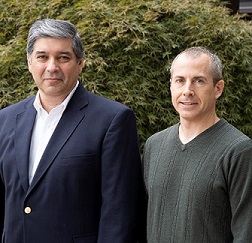October 17, 2018
Dr. Kinzer-Ursem awarded an R61 grant funded by both NIAID and NIMH
Read More about "Dr. Tamara Kinzer-Ursem Awarded $1.4 Million R61 Grant"

October 16, 2018
PIIN Member Vibha Viswanathan Receives Award
Read More about "PIIN Member Vibha Viswanathan Receives Award"

October 5, 2018
R. Claudio Aguilar, associate professor of biological sciences, a world-renowned cell biologist who is making important contributions to understanding Lowe syndrome and the cellular processes associated with this devastating disease. Edward Bartlett, associate professor of biological sciences and biomedical engineering, an internationally recognized neuroscientist who studies the central auditory system to understand the fundamental basis of sound perception and auditory signal processing as well as changes in human hearing with age or acoustic trauma.

October 2, 2018
Dr. Aaron Bowman Receives $318,584 R01 Award
Read More about "Dr. Aaron Bowman Receives $318,584 R01 Award"

October 2, 2018
Dr. Jason Cannon Granted a $336,582 R01 Award
Read More about "Dr. Jason Cannon Granted a $336,582 R01 Award"

September 26, 2018
Millions of birds die each year in collisions with planes, and airports have used everything from fireworks to herding dogs to scare them away. Some methods have been relatively successful, but they’re useless after the plane takes off. Researchers at Purdue University may have just found a solution. Red and blue LED lights lead some birds in the opposite direction, according to a study published Wednesday in the journal PeerJ. Congratulations to Esteban Fernandez-Juricic for his excellent work!
Millions of birds die in collisions each year, but lights could change that

September 15, 2018
Dr. Mathew Tantama, Assistant Professor at the Purdue Department of Chemistry, along with Dr. Chris Rochet, Professor of Medicinal Chemistry and Molecular Pharmacology, has been awarded $192,785 for the initiation of their project of Leucine-Rich Repeat Kinase 2 being a potential treatment for Parkinson's disease (PD) intervention. Congratulations!

August 31, 2018
Tamara Kinzer-Ursem, assistant professor of biomedical engineering, and Janelle Wharry, assistant professor of nuclear engineering have received Early Career Development (CAREER) awards to further their research from the National Science Foundation. Kinzer-Ursem also received an NSF Innovation Corps (I-Corps) grant. Over the next five years, the award will provide Kinzer-Ursem with $550,000 and Wharry with $560,000.
Two Purdue engineering professors honored for early-career achievement, innovation
August 22, 2018
Dr. Bharadwaj received a NSF award for a multi-site project titled "Testing the relationship between musical training and enhanced neural coding and perception in noise".

August 20, 2018
The regulation of pH is essential for proper organelle function, and organelle-specific changes in pH often reflect the dynamics of physiological signaling and metabolism. For example, mitochondrial energy production depends on the proton gradient maintained between the alkaline mitochondrial matrix and neutral cytosol. However, we still lack a quantitative understanding of how pH dynamics are coupled between compartments and how pH gradients are regulated at organelle boundaries. Their results demonstrate the feasibility of studying interorganelle pH dynamics in live cells over time and the broad applicability of these sensors in studying the role of pH regulation in metabolism and signaling. Congratulations to Megha Rajendran, Benjamin Claywell, Emily P. Haynes, Umi Scales, Chace K. Henning, and Mathew Tantama for their work!
Imaging pH Dynamics Simultaneously in Two Cellular Compartments Using a Ratiometric pH-Sensitive Mutant of mCherry